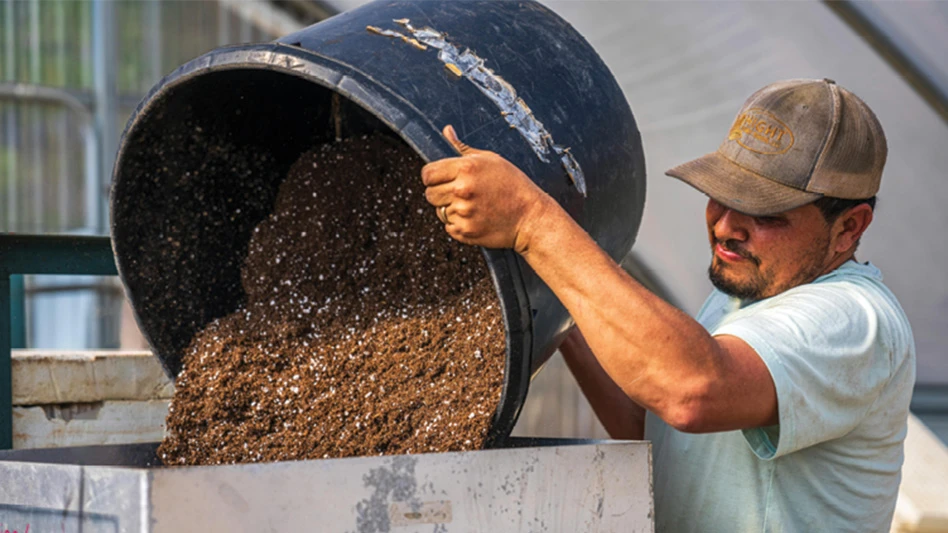
COURTESY OF WELBY GARDENS

Here’s a familiar image for retailers and landscapers in the states of Colorado, Texas, New Mexico, Wyoming, South Dakota, Louisiana, Nebraska, Arizona and Kansas: a young boy with dark overalls and a light-colored baseball cap, his legs and arms stretched out, exuding a wide smile and ecstatic joy. That’s the Hardy Boy Plants logo, dreamed up by Welby Gardens CEO Al Gerace in 1976.

The Hardy Boy Plants logo has come to be recognized in television commercials, newspaper ads, shelf talkers, bench banners and string banners, but it all started with plant tags and labels, Gerace says. “The logo was pretty important,” he says, reflecting on its inception. “It was a vehicle for us to be able to differentiate ourselves in the market, and also to get increased prices for our product because of the way we were growing. About half of our business today is commercial landscapers, and they have to have high-quality plants that will survive.”
The birth of Hardy Boy Plants
In 1972, the Denver grower opened its first retail operation, but it still primarily sold wholesale. Welby Gardens needed a method to promote its product that continued to support the independent garden centers with which it worked, but one that didn’t call immediate attention to its own garden center.
In 1976, Denver was experiencing a drought, and high water-salinity issues spanned not just Colorado’s Front Range, but the several-hundred-mile longitudinal expanse from Casper, Wyo., into Texas. Welby Gardens excelled by growing cold-hardy bedding plants and conditioned them by developing fertilizer programs with high salinity levels.


In coming up with a name for its new finished product brand, “hardy” made sense as an adjective. By that point, Gerace says, hardiness was a flagship of the grower. “We had already had a hard plant — something that you could almost walk on,” Gerace says. “Boy” also made sense to include in the brand name. The Gerace family included six boys who were, at the time, all between the ages of two and 10. Hardy Boy Plants was born.

Gerace claims he isn’t an artist, but he had a vision, and he obtained assistance in creating a lasting logo. “I said, ‘Ok, design me a little boy that kicks his leg out,’” Gerace says. “That’s where it came from.”
Lasting labels and long-term tags
Now, all Hardy Boy Plants packs (18/4 and 10/4) have Hardy Boy tags in them, says Paula Scott, advertising and marketing associate at Welby Gardens. “We have full-color, custom-printed pots in 4.5-inch, Organic 4.3-inch and 1-gallon, and the Hardy Boy logo is also printed on our 1- and 2-gallon pots,” she says. “All the other size pots have ‘Hardy Boy Plants’ and ‘Denver, Colorado’ printed on the label.”
All Hardy Boy Plant tags include general plant and care information, a plant photo and the Hardy Boy Plants logo, Scott says. The company also includes a QR code on its tags for organic plants.
Hardy Boy Plants brand recognition is not limited to horticulture industry professionals. “Customers look for the Hardy Boy logo because they have had proven garden success in the past with our brand,” Scott says. “Also, to see that the plant material is grown locally is very important.”
Through its relationship with independent garden centers, Welby Gardens ensures its plants are in quality condition on the retail shelf and in front of consumers, Gerace says.
If any grower is going to attach its name and image so strongly to a product through its own tags and labels, it should have confidence in its product and that it will perform for all customers in the supply chain. “It puts [the] onus on you to make sure that the whole system goes all the way to the end, to the consumer, as a healthy, viable plant,” Gerace says.

Explore the January 2018 Issue
Check out more from this issue and find your next story to read.
Latest from Garden Center
- AmericanHort urges exclusion of sphagnum peat moss from proposed Canadian tariff
- VIDEO: Garden Center's 2024 State of the Industry Report
- The Growth Industry Episode 2: Emily Showalter on how Willoway Nurseries transformed its business
- Farwest Show calls for 2025 New Varieties Showcase entries
- Oregon Nurseries Hall of Fame member Jack Bigej passes away
- Everde Growers files for Chapter 11 bankruptcy
- DCA Outdoor files for Chapter 11 bankruptcy
- This Florida garden center's busiest days are in the fall, not spring. Find out how they do it





